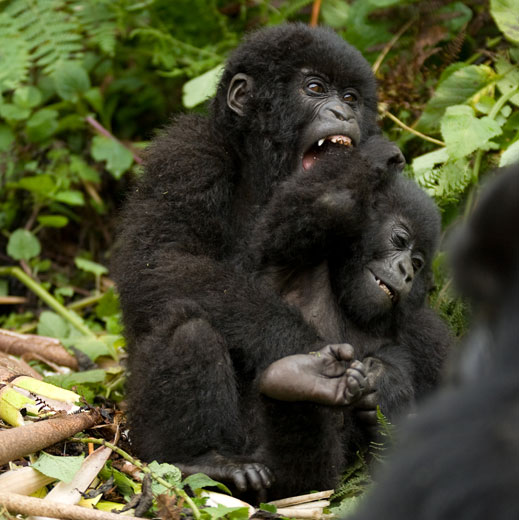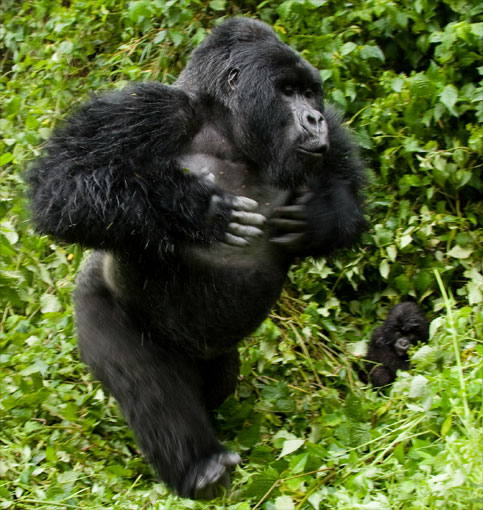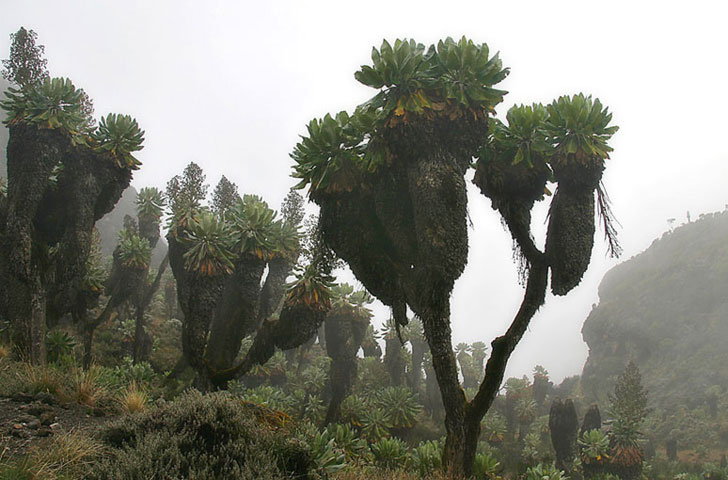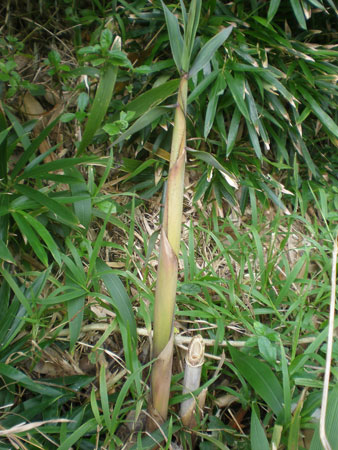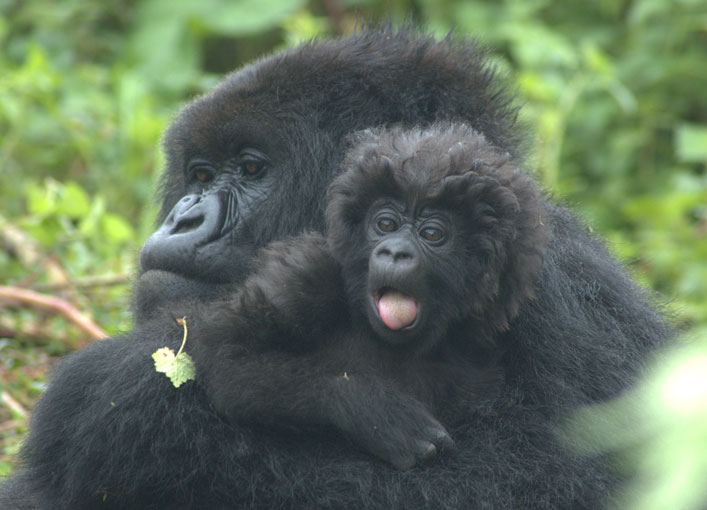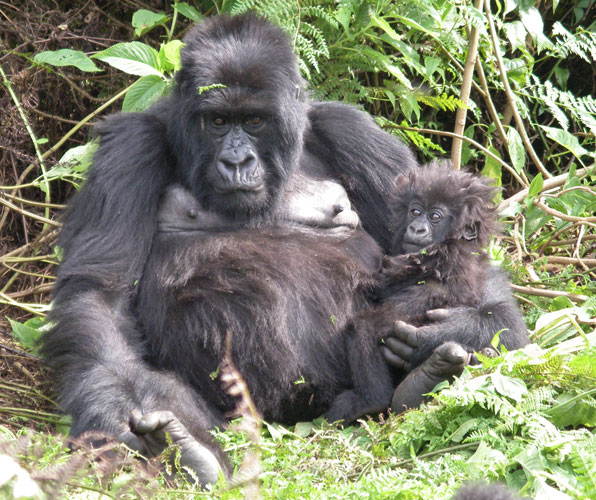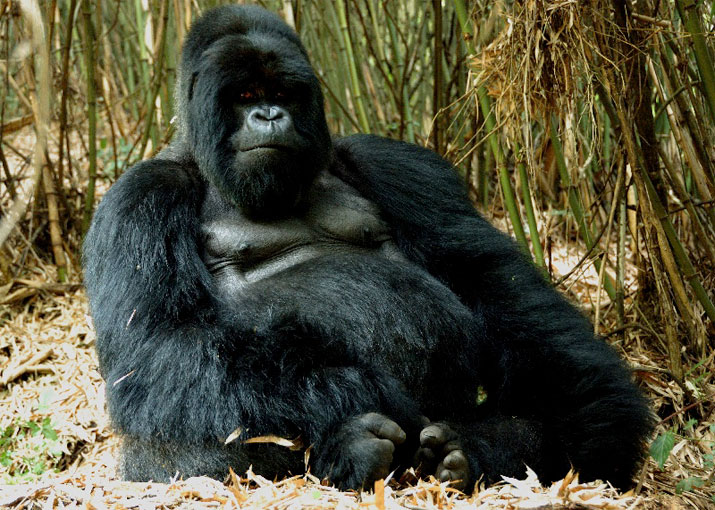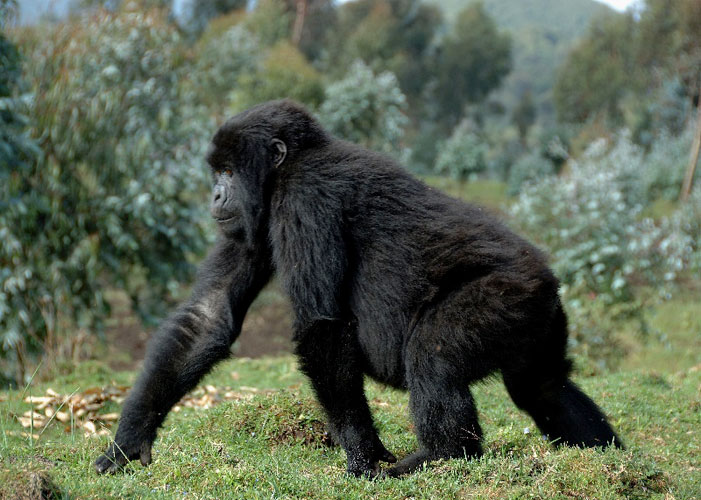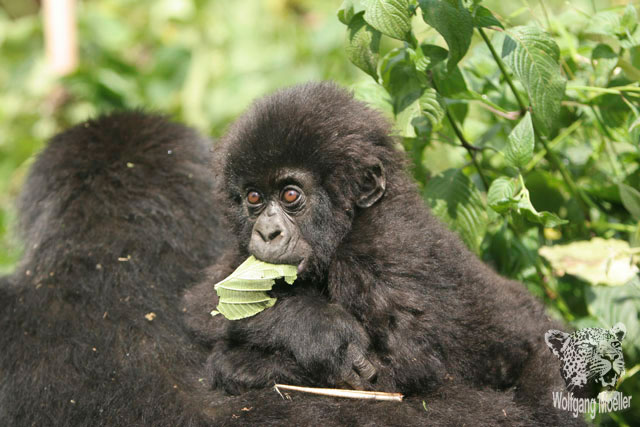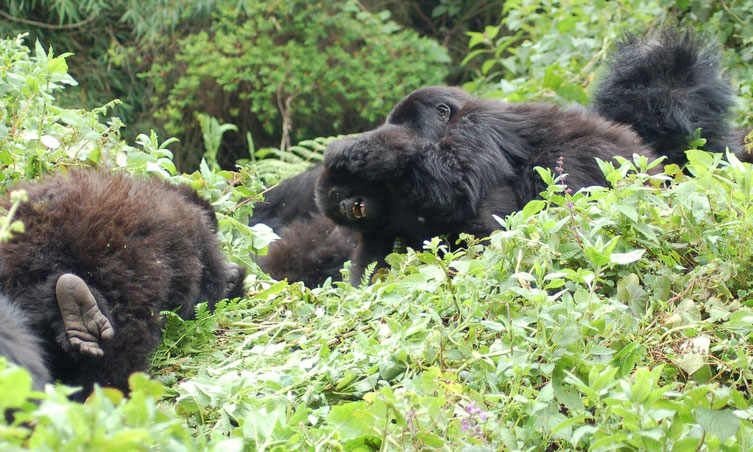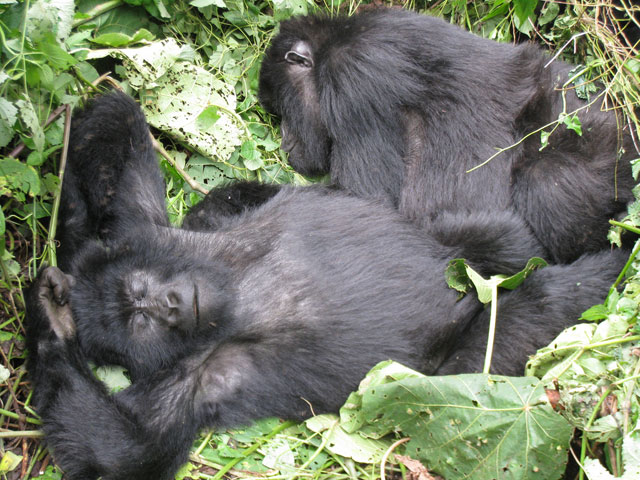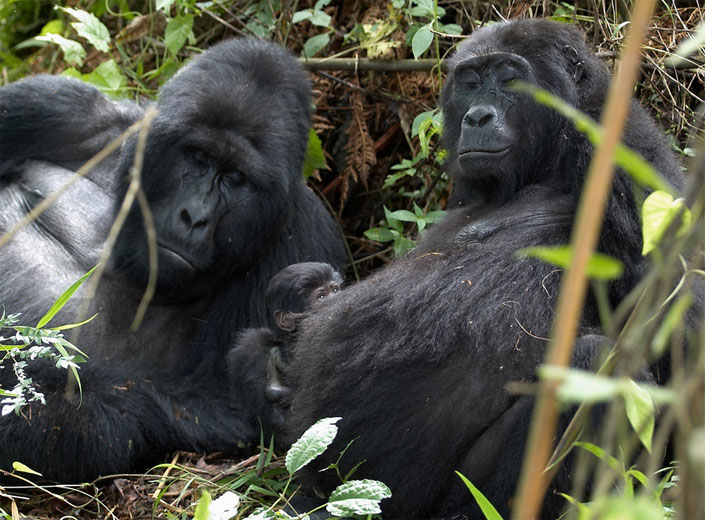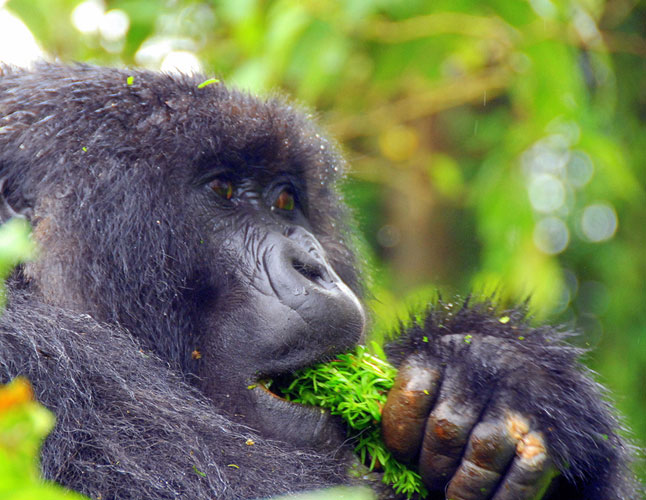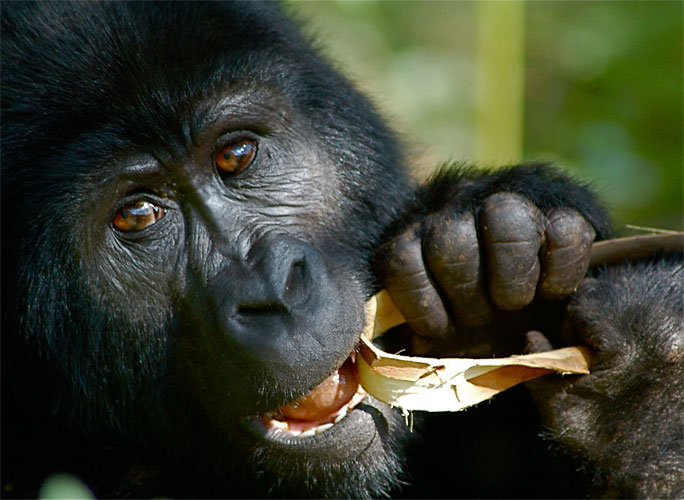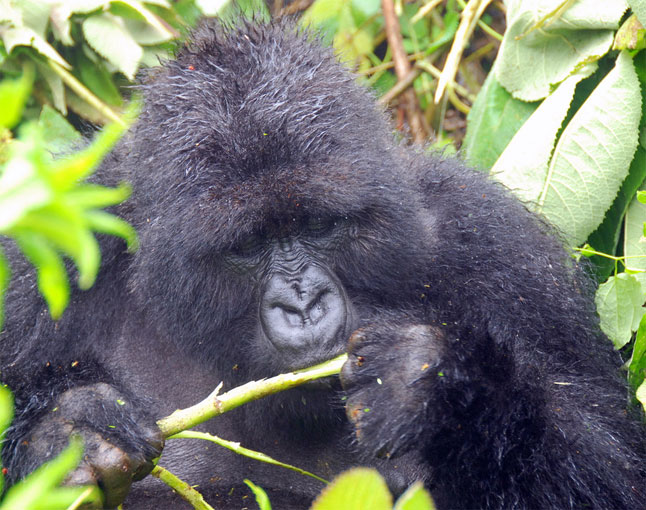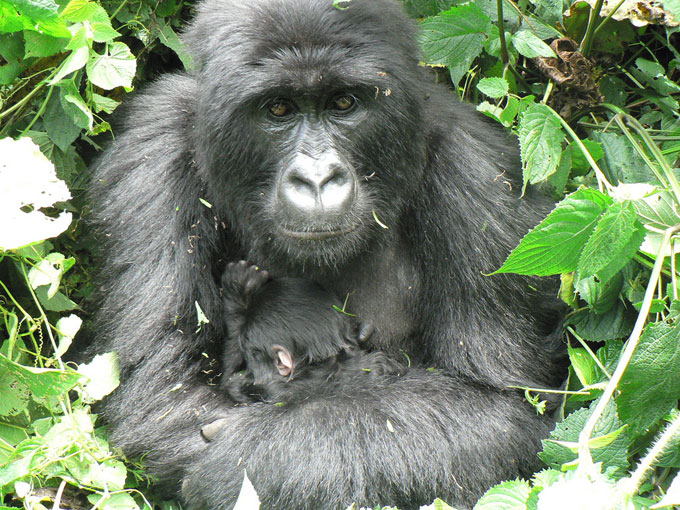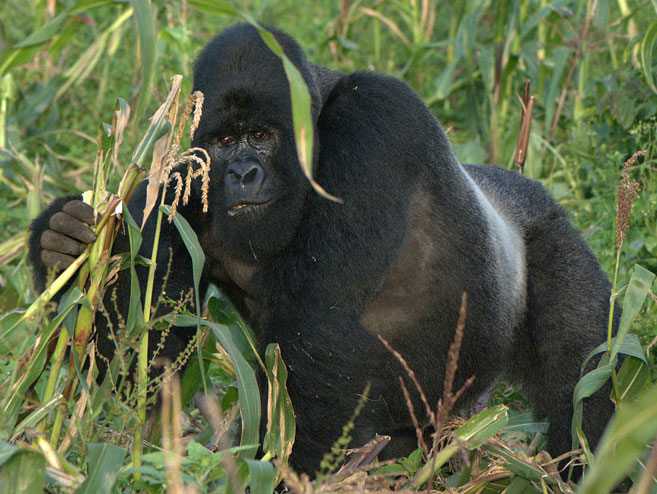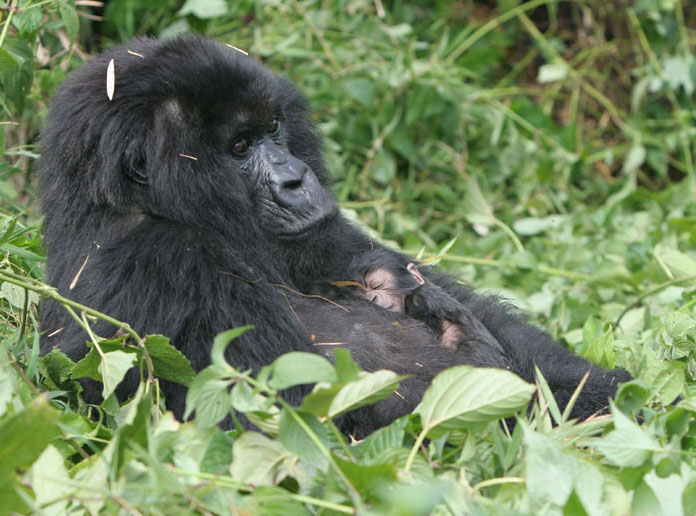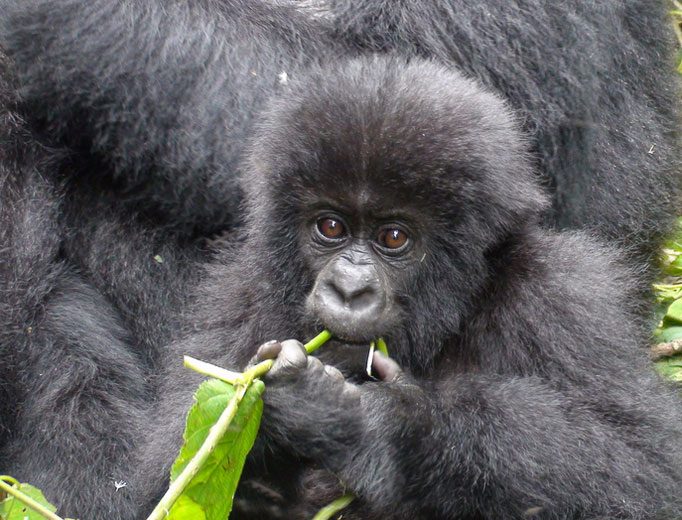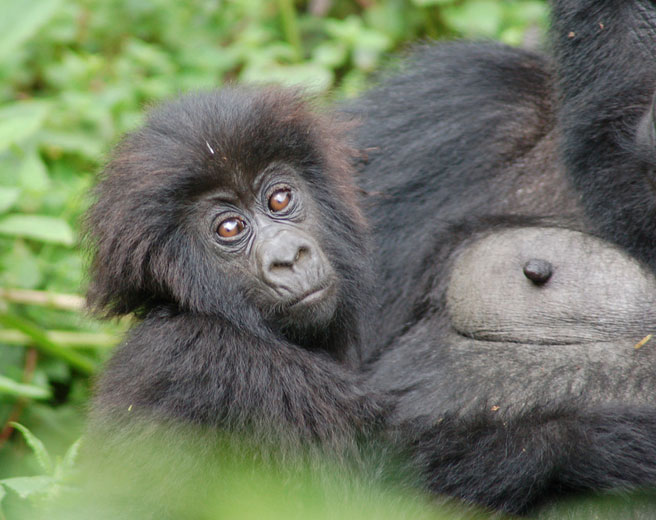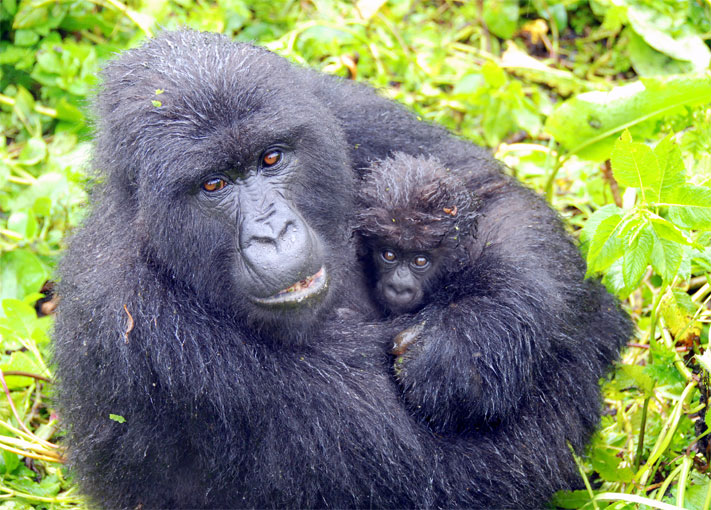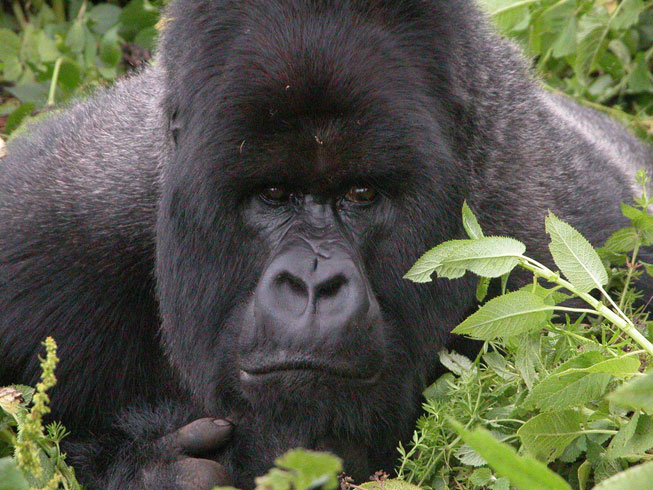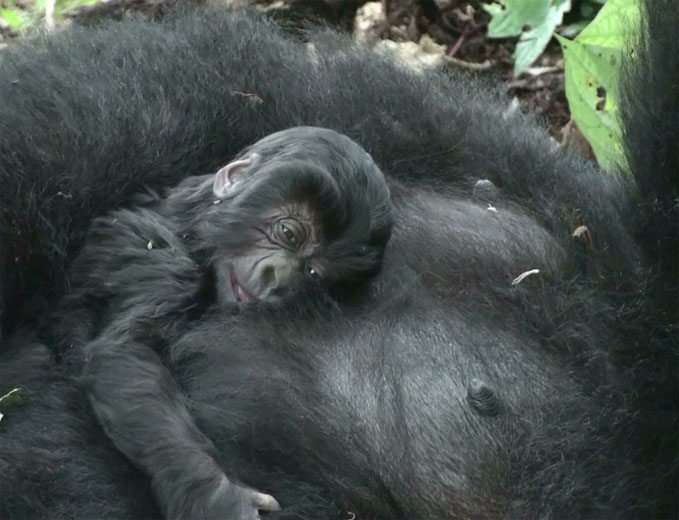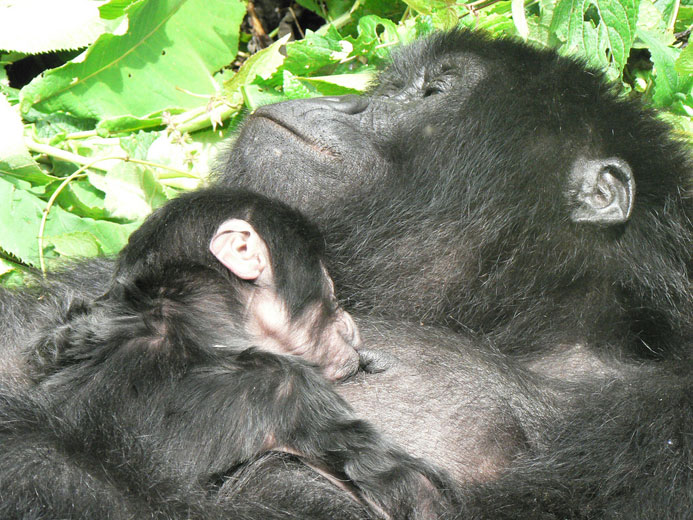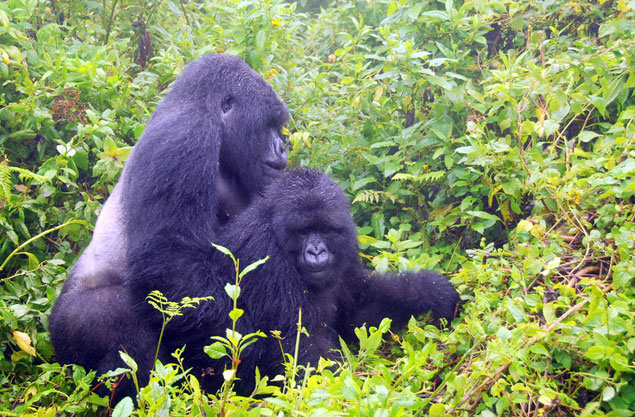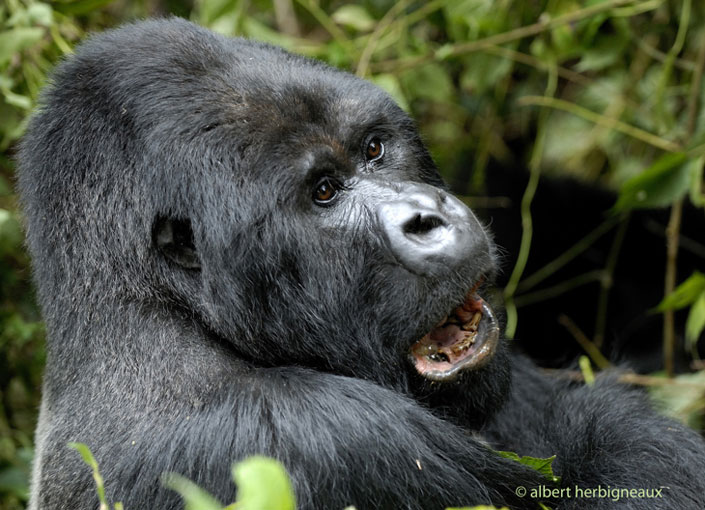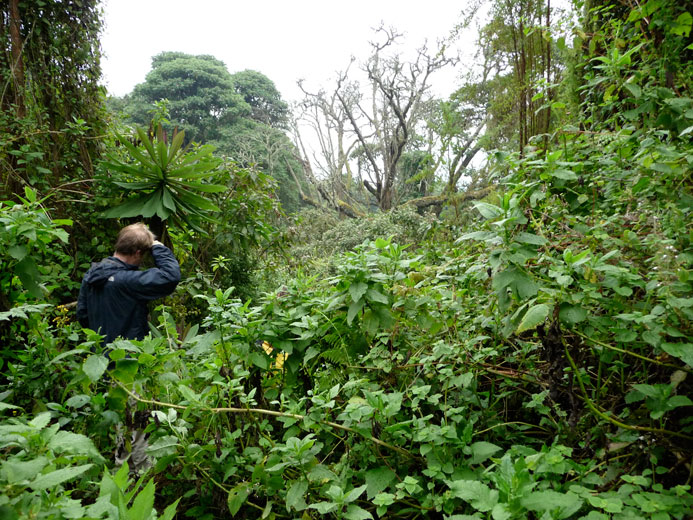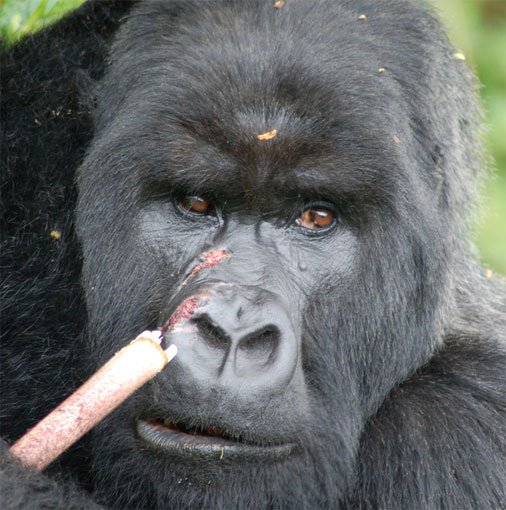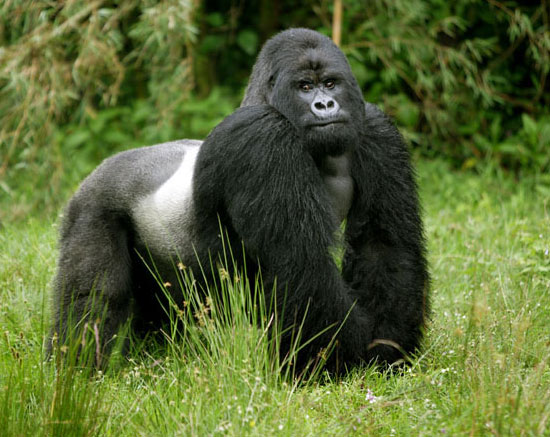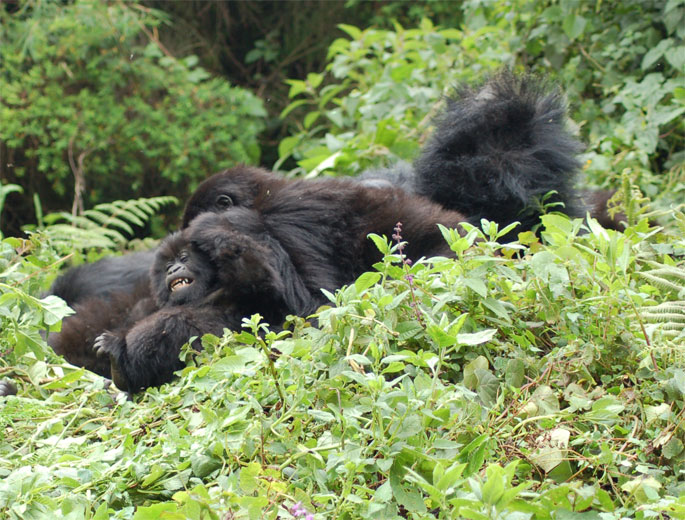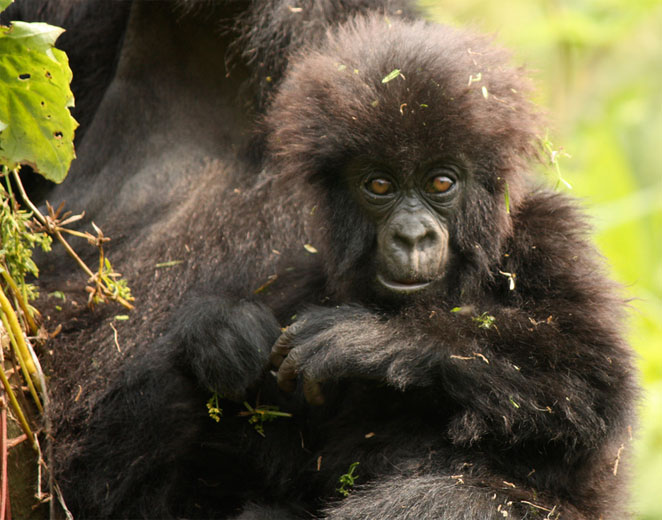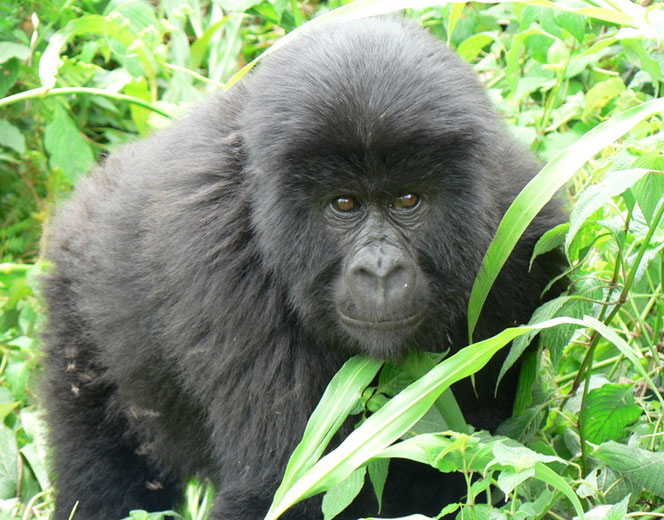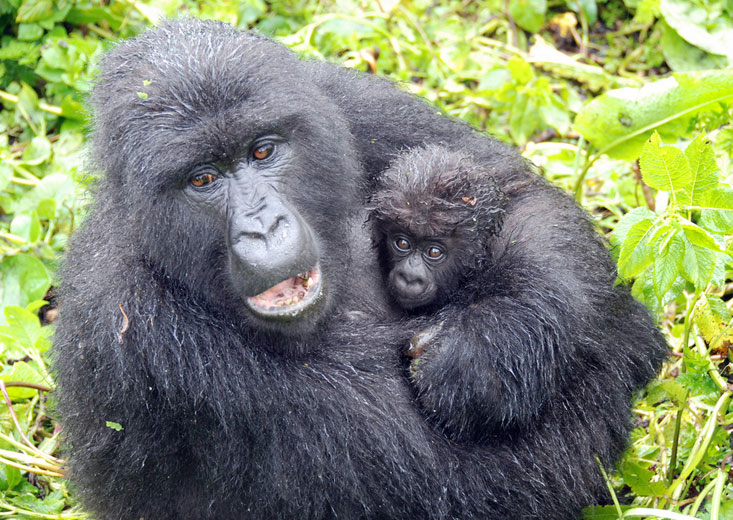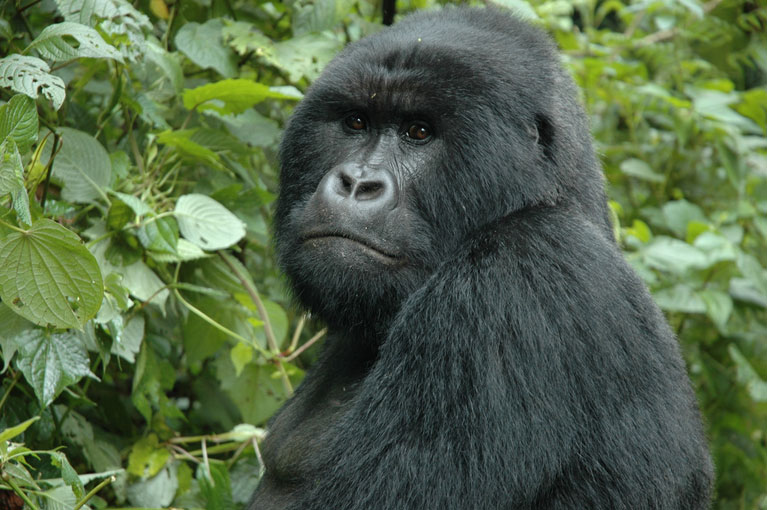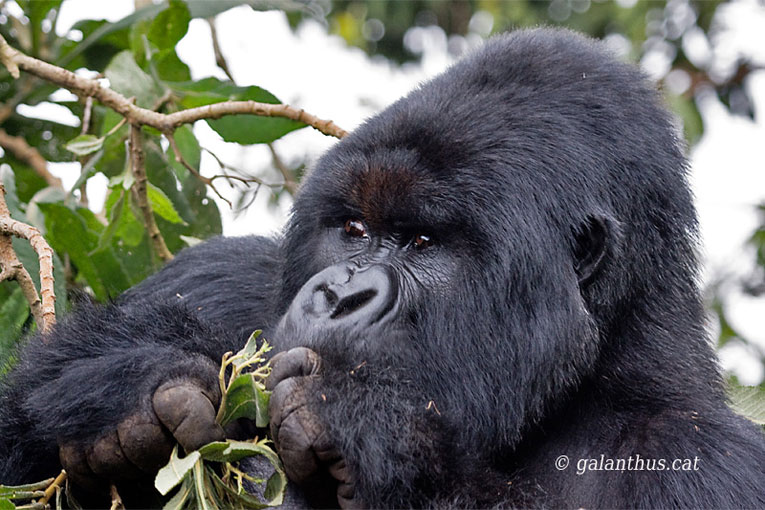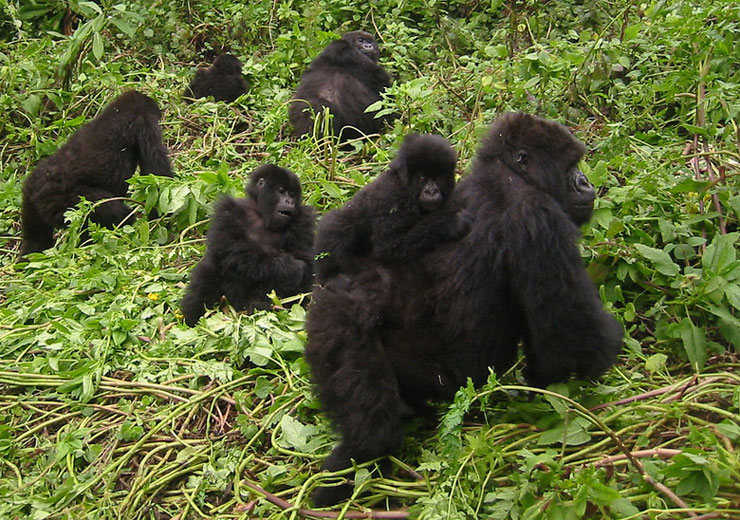|

- Intro
- Silverbacks
- Females
- Infants
- Eating
- Sleeping
- Locomotion
- Communication
- Intelligence
Mountain Gorillas are shy, social animals whose lives are generally peaceful and quiet. They live in family groups of between 2 and 40 members. The average group contains 10 or 12 animals. Of all the great apes, gorillas have the most stable family groups. Each group usually consists of 1 dominant silverback, at least one blackback, several mature females, a few young adults and juveniles, and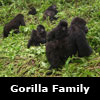 several infants. several infants.
Mountain gorillas spend about 30% of their day eating, 30% traveling and playing, and 40% resting and sleeping. A typical day in the life of a mountain gorilla group will see them rise at daybreak to travel and feed in the morning. They may feed as they move, but will usually find an open area where they can spread out and eat at a leisurely pace. They will take a long rest at midday when they can be seen lounging around, tolerantly fending off boisterous infants and farting continuously and contentedly. The whole afternoon will have them again moving and eating before bedding down at dusk.
Large adult males called silverbacks head their family groups. Silverbacks are named for the distinctive patch of silver or gray hair on the small of their backs, or “saddles”. This graying happens gradually as they get older, just like the hair on the head of an older person. This may be in order to intimidate his enemies,  by making him appear larger than he really is. When a solid block of color is broken up with another color in the middle, the object seems longer in an optical illusion. by making him appear larger than he really is. When a solid block of color is broken up with another color in the middle, the object seems longer in an optical illusion.
Silverbacks are strong, dominant troop leaders. Their power not only derives from their size but the fact that they are the protector of the group. They mediate conflicts within the group and protect the group from outside dangers such as intruding silverbacks from other groups, poachers, and other animals. The younger male blackbacks may serve as backup protection.
Although peaceful and not aggressive by nature, silverbacks will charge anything that threatens their group. Usually the charge is just a bluff; they will rarely physically attack another animal. Other intimidating behaviors include chest-beating, hooting, screaming, breaking branches,  baring teeth, standing erect on the hind legs, tearing up and throwing plants, stamping the feet, and striking the ground with their hands. These displays help prevent serious conflict not only between groups, but also among males in the same group. Silverbacks will exude a pungent odor from their sweat glands when the get excited or nervous. baring teeth, standing erect on the hind legs, tearing up and throwing plants, stamping the feet, and striking the ground with their hands. These displays help prevent serious conflict not only between groups, but also among males in the same group. Silverbacks will exude a pungent odor from their sweat glands when the get excited or nervous.
When it is necessary for silverbacks to fight, it is very important for them to be able to fight well. First, they need to protect the group from predators. They also need to compete with lone males for the right to keep their group and to mate with females. Although fights usually end before anyone gets hurt, it is when these interlopers challenge a silverback for control of his group that serious violence is most likely. males for the right to keep their group and to mate with females. Although fights usually end before anyone gets hurt, it is when these interlopers challenge a silverback for control of his group that serious violence is most likely.
When male gorillas are around 12 years old, the hair on their lower backs start to shorten and turn silver. If they are unable to take over the group from the dominant silverback, they will often leave the group and may wander alone or with other males for a few years before they are able to attract a female and form their own family. They will go out of their way to meet females, sometimes following another group for days in order to determine if the silverback is vulnerable to being overtaken, or if they can lure a mature female from the group. Frequent contact with different groups probably provides them with useful knowledge of neighboring gorillas and areas.
A group’s home range will frequently overlap with another group’s, making contact likely. Gorillas continually wander through their home ranges of 10 to 15 sq miles (25 – 40 sq. km), feeding and resting throughout the day. Competition between males over mating often influences a group’s home range as the silverback will lead them away from areas  with lots of strong rivals. Solitary male mountain gorillas travel further than groups which increases their chances of making contact with a variety of potential mates. with lots of strong rivals. Solitary male mountain gorillas travel further than groups which increases their chances of making contact with a variety of potential mates.
If a silverback is successful in taking over his group, or attracting a female with an infant, the new silverback will usually kill the babies that are not his. This practice of infanticide is due to the fact that females naturally only give birth every 4 years. Most cases of infanticide occur when the infant is less than 18 months old. With the death of her infant, she will stop lactating and go into estrus. This will allow him to mate, and thus be able to ensure his own bloodline at least 2 years before he would have otherwise. Females may try to thwart this by mating with more than 1 male in a multi-male group, thus creating paternity confusion. When the dominant male dies, the new leader will have mated with the mothers and treat infants in the group as his own.
About 60% of females end up emigrating to other groups, usually when they mature at around the age of 8. One reason for this is that the dominant male in a group with only one silverback almost exclusively fathers the babies in his group. If the maturing female's father is successful enough to still be the main breeder in the group, she will be forced to leave in order to avoid inbreeding. In this way genetic diversity is improved when a female joins another group. As a new member of a group, the female gets to choose whom she will mate with, but the other females of the group decide if they will allow her to stay.
Adult females in a group do not socialize with each other except for the ones that are closely related, like mothers and daughters as well as sisters. Unlike many other primates, it is the bond between each female and the silverback, rather than bonds between the females that keep the group cohesive. As the head female grooms the dominant silverback, she is exerting her status while teaching the others how to do it. The length of time a female spends grooming a silverback depends on when she entered the group; newcomers go last. If the leader is killed by disease, accident, fighting or poachers, the females will disperse and join other groups or look for a new protective male. Because gorillas have such strong bonds to their dominant silverback, even when groups meet and mingle, each one tends to remain with its original unit when they part ways. it is the bond between each female and the silverback, rather than bonds between the females that keep the group cohesive. As the head female grooms the dominant silverback, she is exerting her status while teaching the others how to do it. The length of time a female spends grooming a silverback depends on when she entered the group; newcomers go last. If the leader is killed by disease, accident, fighting or poachers, the females will disperse and join other groups or look for a new protective male. Because gorillas have such strong bonds to their dominant silverback, even when groups meet and mingle, each one tends to remain with its original unit when they part ways.
Newborn gorillas are weak and tiny, usually weighing about 2 kilos, about half as much as a human newborn. For the first 4 to 5 months, their movements are awkward and they never leave the safety of their mother. With fragile hands, they are either clinging onto their mother’s belly hair and chest or held in one arm while the mother feeds. Since they don’t need to eat as much as 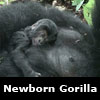 adults, infants have a lot of time to play. They develop necessary physical skills by doing somersaults, climbing trees, swinging from branches, and sliding down hills. adults, infants have a lot of time to play. They develop necessary physical skills by doing somersaults, climbing trees, swinging from branches, and sliding down hills.
They drink their mother’s milk exclusively for the first year. They then start to eat the plants they see their mother eating. It takes time, however, for them to learn how to eat stinging nettles and prickly thistles, which are difficult to prepare with their clumsy little hands. Although they are eating more plants, infants continue to wean until they are 3 or 4 years old. They continue to sleep with their mother in her nest until the next baby is born. Infant mortality is high; in the Virungas, 26% of infants die during their first year and 34% before they are 3 years old.
Mountain gorillas are primarily herbivores. Their diet is made up of over 100 different plants including wild celery, stinging nettles, thistles, leaves, roots, herbs, vines, and grasses. Occasionally they will eat ants, along with an odd worm or grub. They will also feed on small amounts of tree bark, wood, roots, flowers, fruit, and berries. 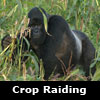 Gorillas spend about 30 percent of each day foraging for food. Gorillas spend about 30 percent of each day foraging for food.
The greatest advantage to their diet is that there is a lot of it where they live and it is available year-round. Also, the plants contain a lot of water so they can go most of the year without drinking. The main disadvantage is that it is not very wholesome, so they have to eat huge amounts in order to obtain the necessary energy and nutrients. This is why they have huge bellies and look bloated. Another challenge is that plant material contains cellulose, which is hard to digest. Gorillas have a single stomach and long intestine, just like us humans. So they need to rely on microbes living in their colon to break down the cellulose and turn it into carbohydrates through a process called fermentation. Cellulose also causes flatulence, so they pass a lot of gas throughout the day.
Mountain gorillas spend a lot of their time traveling in search of food, as some plants and trees change with the seasons. Gorillas in the Virungas love to eat bamboo shoots when they are still green and tender, which are only available during the rainy season. During the dry season they enjoy the delicacy of wild black berries. 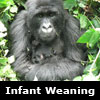 They also like to eat the soft centers of the giant senecio trees, so they will hike up way up the mountainsides to the subalpine zone where these plants live. Because Bwindi gorillas live at lower elevations, they eat more fruit, which doesn't grow well at the higher elevations of the Virungas. Researchers surmised that, because they travel further during the fruiting season, they don't just eat it when they stumble upon it, they actively search it out. They also like to eat the soft centers of the giant senecio trees, so they will hike up way up the mountainsides to the subalpine zone where these plants live. Because Bwindi gorillas live at lower elevations, they eat more fruit, which doesn't grow well at the higher elevations of the Virungas. Researchers surmised that, because they travel further during the fruiting season, they don't just eat it when they stumble upon it, they actively search it out.
Just like humans, gorillas are diurnal. Because they are nomadic, they usually end up in a new location each night. At dusk, they prepare nests by shoving vegetation under and around themselves. They will bend soft trees and use plants with broad leaves to provide cushioning and a blanket against the cold. Almost all of the nesting material will be made from plants the gorillas don't eat, since food plants such as thistles, 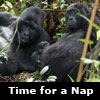 nettles, and celery aren't comfortable to rest on. The nests are arranged around the dominant silverback and are used only once. They defecate in them in the morning before moving on around dawn. But if it is cold or overcast they may lounge around for a while. nettles, and celery aren't comfortable to rest on. The nests are arranged around the dominant silverback and are used only once. They defecate in them in the morning before moving on around dawn. But if it is cold or overcast they may lounge around for a while.
Gorillas curl up alone in their own nest, except for mothers who sleep with their infants. These mothers will find a comfortable spot where their backs will be supported as they breast feed and cuddle their babies for the night. This lasts until the infants are 3 or 4 years old, when they start to build their own nests. The fact that mountain gorillas sleep one to a nest makes it easy to estimate a local gorilla population. Researchers simply count the number of nests left by each group.
Mountain gorillas also rest in the middle of the day. This is an important time for social bonding within the group. Mutual grooming reinforces social relationships, and helps keep hair free from dirt and parasites. Mothers groom their youngsters often. Young gorillas don’t need as much rest as adults, so this is when they will play with other infants and juveniles.
Gorillas spend almost all of their time on the ground. They are mainly quadrupeds and get around by knuckle-walking. They rarely move bipedally as humans do. They can stand for short periods, usually to reach tall plants and while they beat their chests; it 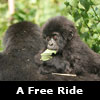 makes them look more menacing. makes them look more menacing.
They can climb trees, but young gorillas are much more arboreal than the large adults, who usually will only do so to reach fruit in a tree. Gorillas cannot swim. Groups usually move less than one km per day. They usually only move longer distances when they have had a stressful encounter like an aggressive confrontation with a lone male.
Gorillas are generally quiet animals. But they are very social, so communication is important. Communication is used to teach the young the many skills that they need to survive, and for other gorillas to communicate about food, social relationships, distress, and mating. Gorillas communicate using visual signals (gestures, body postures, facial expressions), auditory signals (vocalizations), olfactory signals (odors), and tactile behavior (grooming).
The most well-known gorilla gesture is chest beating (actually they slap with open hands). Males do this to show stature, warn other groups or even to prevent a fight. For the silverback, chest beating is a show of power, designed to intimidate. Air sacks on both sides of the adult’s larynx amplify the sound.  But even infants beat their chests as part of their play, mimicking their elders. But even infants beat their chests as part of their play, mimicking their elders.
Chest beating can also be part of a display that is one of the most magnificent animals behaviors in nature. It begins with soft hoots. The silverback then puts a leaf in his mouth and rises on his hind legs, now hooting faster. He then grabs a handful of vegetation and throws it high in the air. Next he beats his massive chest with cupped hands, which is so loud it can be heard miles away. Then he runs sideways, slaps or tears at more vegetation, and finally thumps the ground with heavy palms. When he starts this display, the females and infants flee to a safe distance, much like humans do when someone in the family starts acting crazy and throwing things. It is thought that the cause of this display is the build up of tension in any exciting situation and is meant to intimidate.
Silverbacks will walk rigidly in a dominance display, mainly when a lone male is trying to lure a female away from the group. They have their arms bowed and hair bristled so that they look bigger. They take short steps, have their side facing the intruder, and only look at him with a few glances.
Males also lunge or charge, whether at an outsider or at someone within the group itself. It is sometimes accompanied with a terrifying scream. Most of these actions are just meant to serve as warnings, to ward off danger or to prevent a fight. Gorillas crouch low and approach from the side when they are being submissive and approach directly when confident.
Facial 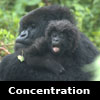 expressions are also used for communication. For example, an open mouth with both upper and lower teeth showing means aggression. A closed mouth with clenched teeth and head jerks signal anger. They tuck their lips when they are tense. Gorillas are angry or annoyed when they stare at another, with eyebrows lowered and head angled down. If the stare is accompanied by bared gums and teeth and lips curled back, it is meant to threaten potential predators. It is often combined with a mock charge, screams, and roars. Infants will pout when their mother leaves them or they don't get what they want. Their lips are pursed and slightly parted and their eyebrows are raised in this distress signal. Gorillas are afraid when their mouth is expressions are also used for communication. For example, an open mouth with both upper and lower teeth showing means aggression. A closed mouth with clenched teeth and head jerks signal anger. They tuck their lips when they are tense. Gorillas are angry or annoyed when they stare at another, with eyebrows lowered and head angled down. If the stare is accompanied by bared gums and teeth and lips curled back, it is meant to threaten potential predators. It is often combined with a mock charge, screams, and roars. Infants will pout when their mother leaves them or they don't get what they want. Their lips are pursed and slightly parted and their eyebrows are raised in this distress signal. Gorillas are afraid when their mouth is  wide open, the eyebrows are raised, their eyes move back-and-forth, and their head is tilted back. wide open, the eyebrows are raised, their eyes move back-and-forth, and their head is tilted back.
Males emit a strong, pungent odor from glands under the armpits. They do this when excited or faced with an aggressive threat.
Gorillas groom each other to remove parasites from each other's hair and to increase social bonds within the group. Females will groom the silverback and their youngsters, but not each  other unless they are closely related. Immature gorillas will also groom each other. Grooming is almost always initiated by the mother and protested and finally stopped by the infant, just like people! other unless they are closely related. Immature gorillas will also groom each other. Grooming is almost always initiated by the mother and protested and finally stopped by the infant, just like people!
Please be patient- we are awaiting audio files for the vocalizations listed below.
Because mountain gorillas live in dense vegetation where it is difficult to see each other, the main form of communication is through vocalizations. There are about 25 distinct vocalizations and each has its own meaning. Grunts and barks are heard most frequently while traveling, and tell the gorillas the whereabouts of other group members. They are also used to scold or discipline youngsters. Silverbacks will hoot loudly when they see another group and it is a warning to keep their distance. Other gorillas will hoot when they have been separated from their group. Screams are loud and can be repeated many times, especially by gorillas who are upset or fighting. Roars are given by adult males and signal alarm or warning. The group usually hides behind the silverback when hearing this. Deep rumbles, belches, and grunting communicate contentment and are heard frequently when they are feeding and resting. Pig grunts are a series of short guttural noises and signal that the gorilla is annoyed with another gorilla in his group. Young gorillas will hoot, holler, scream, and chuckle when they are playing and cry when they are distressed.
Gorillas and humans evolved from a common ancestor, share 98.4% of each other’s DNA, and like human beings, are intelligent, playful, emotional, and family-oriented. Different gorillas exhibit different personalities, just like humans. Some move differently than others, some are more curious than others. Some are confident; some are shy. Some are nervous; some are calm. Some even seem to have a sense of humor!
Gorillas have emotions and feelings similar to humans. They can be curious, bored, annoyed, excited, afraid, and worried. They can have pleasure, get excited, be afraid, show affection, be thoughtful, and be hostile. Dian Fossey observed a brother and sister, ages 3 and 7, sulking off with lower lips hanging down when a mother denied their attempts to cuddle and groom her infant. She also saw the entire group huddle around their now dead silverback, apparently in mourning.
Mountain and lowland gorillas are thought to have similar intelligence. Mountain gorillas have not been observed using tools, so they are thought to be less intelligent than chimpanzees, who use them frequently. This may not be a good indicator of intelligence however. Gorillas may not need to use tools because their food is so abundant and easy for them to get to. For example, chimpanzees have been observed fishing for termites with sticks, whereas gorillas will simply smash the mound to get to the termites. They are so strong that, for them, it is a more efficient method.
Lowland gorillas have only recently been seen using tools. An adult female gorilla was observed using a branch as a walking stick to test water deepness and to aid in her attempt to cross a pool of water in a swampy forest clearing in northern Congo. Another researcher saw a different adult female using a detached trunk from a small shrub to dig for herbs. She then used the trunk as a self-made bridge to cross a deep patch of swamp. In contrast to chimpanzees using tools use to obtain food, it appears that gorillas use them to navigate their habitat, which is a more challenging task for them.
Perhaps the best indicator of Gorillas’ intelligence is the world famous Koko, a female lowland gorilla born in captivity in 1971 and taught American Sign Language since she was 1 year old. Koko has a working vocabulary of over 1000 signs and understands approximately 2,000 words of spoken English. Koko initiates the majority of conversations with her human companions and typically constructs statements averaging three to six words. Koko has a tested IQ of between 70 and 95 on a human scale, where 100 is considered "normal”.
This photo was actually taken by Koko in 1978 (when she was just 7 years old), and the photo she's snapping is of herself aiming the camera at the mirror. This photo alone dispelled two major misconceptions about gorillas: 1) that they were incapable of using tools, and 2) that they were not capable of recognizing themselves in a mirror — a cognitive ability that is supposed to be necessary for self-awareness. Since then, Koko has gone on to dispel many other myths about gorillas (and other great apes) such as showing how gentle they can be with humans and even tiny kittens, that they are capable of the full range of human emotions, that they can empathize with others, have a sense of humor, can be embarrassed, and that they can feel and express both physical and emotional pain (e.g., grieving for her kitten) and deep love and a sense of kinship across species (e.g., with Dr. Penny Patterson). Moreover, they are highly intelligent and can use technology (e.g., VCRs, remote controls, computers, phones) — and even language (sign language in Koko's case) — in both conventional and innovative ways.
|
|
|
intimidate v. To frighten or overwhelm someone,
especially in order to make them to do something.
n. Sounds or words coming from the vocal cords
that are meant to communicate something.
adj. Ready to conform to the authority
or will of others. Obedient.
n. One who comes without
permission or being invited.
v. To stand stiffly like the bristles of a wire brush.
v. To copy or imitate closely, especially in
speech, expression, and gesture.
n. The muscular section of the throat that
contains the vocal cords.
n. The natural height of a human or animal in an
upright position. An achieved level; status.
n. An organism that grows, feeds, and is sheltered
on or in a different organism while contributing
nothing to the survival of its host.
v. To infer something without sufficiently
conclusive evidence.To make a guess.
n. Something pleasing and appealing,
especially a choice food.
n. The presence of excessive gas in the
digestive tract. Self-importance.
n. A group of chemical reactions that
split complex organic compounds into
relatively simple substances.
n. Organic compounds that include sugars and starches
and serve as a major energy source in the diet of animals.
n. A complex carbohydrate that is
composed of glucose and is the
main part of the cell wall in most plants.
adj. Swollen beyond normal size
by fluid or gaseous material.
n. A nourishing ingredient in a food source.
v. To look for or search for
food or provisions.
n. An animal that feeds chiefly on plants.
n. The number of deaths of infants per 1000 live births.
v. To drive off or scatter in different directions.
n. Position relative to that of others; standing.
v. To put to use, put forth, or bring to bear,
sometimes with strenuous effort.
adj. United or stuck together.
n. The breeding of related individuals within an
isolated or a closed group of animals or people.
n. An animal who produces offspring.
A person who breeds animals or plants.
v. To leave one country or region to settle
in another. The opposite of immigrate.
n. The state of being a father; fatherhood.
v. To prevent the occurrence or attainment of.
To stop something from happening.
n. Direct line of descent; pedigree
n. The periodic state of sexual excitement in the
female of most mammals, excluding humans.
It precedes ovulation and is when the female is
most receptive to mating; going into heat.
v. To produce milk.
n. The act of killing an infant. The
practice of killing newborn infants.
v. To tempt or attract with the promise
of pleasure or reward.
n. One that interferes with the affairs
of
others, often for selfish reasons.
adj. Having a penetrating, biting, or caustic
taste or smell.
v. To ooze forth.To discharge or emit.
adj. Rough, violent, loud, noisy, and
lacking in restraint or discipline.
adv. To move around on the legs only.
adj. People or animals who have no fixed
home and move from place to place in
search of food and water.
adj. Active during the daytime rather than at night.
n. Microscopic bacteria that cause
disease or fermentation.
Between 4 and 5 lbs
n. The geographic area to which an
animal normally confines its activity.


